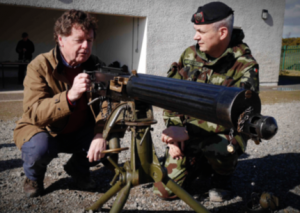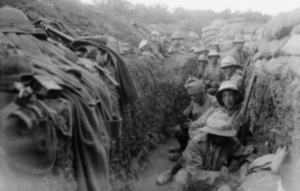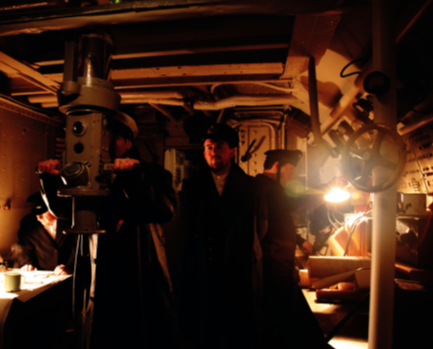Gallipoli: Ireland’s forgotten heroes; Lusitania: 18 minutes that changed the world
Published in Issue 4 (July/August 2015), Reviews, Volume 23Gallipoli: Ireland’s forgotten heroes
RTÉ1, 21 April
Lusitania: 18 minutes that changed the world
RTÉ1, 7 May
By John Gibney

Presenter David Davin-Power—whose grandfather served in Gallipoli—learns about the weapons that would have been used. (RTÉ)
In specifically Irish terms, there are three major centenaries being marked in 2015: the Gallipoli campaign, the beginning of which on 25 April was rapidly followed by the anniversary of the sinking of the Lusitania on 7 May 2015, and, looking forward, the anniversary of the funeral of Jeremiah O’Donovan Rossa, which will mark the opening of the extensive and ambitious programme to commemorate the cent-enary of the Easter Rising next year. RTÉ productions will no doubt feature prominently in next year’s centenary, but aside from its news coverage of the anniversaries, the state broadcaster gave the Gallipoli and Lusitania centenaries a dedicated documentary each.
Gallipoli: Ireland’s forgotten heroes was presented by David Davin-Power; his grandfather served in Gallipoli, which offered a personal connection. It provided a good, solid overview of the Irish involvement in the campaign (recently dramatised in PALS, reviewed in our last issue), with a range of expertise on display (John Horne, Heather Jones, Lar Joye, Jeff Kildea and Philip Orr, amongst others); it also made a point of including Turkish voices, thereby offering an insight into the experience of those who defended the Gallipoli peninsula in the face of the Allied assault.

Troops of the 10th (Irish) Division in front-line trenches during the August 1915 offensive at Suvla Bay.
The subtitle—‘Ireland’s forgotten heroes’—makes the assumption that the men who died in the First World War will automatically be regarded as heroes. It is a view that was recently challenged by commentators such as Fintan O’Toole and Eamon McCann: the constant refrain that these men were heroes places them, and by implication the circumstances of their deaths, beyond critical scrutiny. It also raises the question of how one defines a hero, a question that has a vexing relevance in relation to the commemoration of both the Irish who fought in the First World War and those who fought in the independence movement; as suggested by Philip Orr, considering the manner in which Irish independence was won, the marginalising of the veterans of the Great War was ‘understandable’. But there were strikingly ecumenical sentiments on display here from families who had members that fought in Gallipoli and were of the view that their ancestors should be remembered. Many had no problem expressing a respect for both those who fought in the war and those who fought in the Easter Rising (a tolerant stance that some other relatives of veterans of the Irish revolution could learn from). Indeed, both form part of the same history, and neither can exist in isolation from the other: Heather Jones observed that the impact of Gallipoli—its human cost—sowed seeds of doubt in Ireland about the validity of John Redmond’s support for the war. This pre-dated the Easter Rising; one factor behind the rapid rise of Sinn Féin after the Rising was that support for the war had tainted nationalist Ireland’s traditional political leaders. Nationalist Ireland might have been in the market for a change of leadership even aside from the fact that the Easter Rising inadvertently provided an alternative.
It is striking that in much commentary on the Irish involvement in the war an emphasis on the dead can obscure consideration of the survivors. It was refreshing that Gallipoli: Ireland’s forgotten heroes did not forget those whose fate was far from heroic: the documentary touched upon the long-term impact that the horrors of war had on those veterans who survived. Trauma, as John Horne observed, was the wound that did not show. This was a thoughtful and well-made documentary. Mention should also be made of another initiative to mark the Gallipoli centenary in which RTÉ is involved. The Century Ireland project has developed an on-line exhibition dedicated to the Gallipoli campaign, which incorporates a wide variety of essays, image galleries, maps, educational resources, real-time reports and interviews (including one with Cait O’Riordan, the former bassist in The Pogues, discussing how Eric Bogle’s anti-war song about Gallipoli, The band played Waltzing Matilda, ended up as the last tune on their 1985 classic Rum, sodomy and the lash). It is an excellent resource, attractively designed, user-friendly and full of very substantial content; it is easily the best on-line resource to have been developed to date for the Irish ‘Decade of Centenaries’.
Lusitania: 18 minutes that changed the world
RTÉ1, 7 May

Above: The crew of the German U-20 prepares to attack in the drama-documentary Lusitania: 18 minutes that changed the world. (RTÉ)
Lusitania: 18 minutes that changed the world was very different from RTÉ’s Gallipoli offering. It was a drama-documentary that explored the lives of a handful of the passengers who were on the liner in May 1915 when it was torpedoed by a U-boat twelve miles off the Cork coast, and sank in eighteen minutes with the loss of just under 1,200 lives. The scale of the disaster is thus compar-able to the sinking of the Titanic, though as the Lusitania sank during a war in which such things might be expected to happen it has never acquired the same iconic status. The sinking of the Lusitania has sometimes attracted sinister allegations that the British deliberately used it as bait of a sort in the hope that its sinking might cause sufficient outrage in the US to guarantee their entry into the war (this outrage undoubtedly contributed to the climate in which the US would enter the war in Europe in 1917). The ship was carrying some war material, but hardly enough to justify the decision of U-19 to deem it a legitimate target and destroy it. Drama-documentaries can be a necessary evil in the absence of footage from the past that they wish to portray, but this was, in truth, less than riveting television. Given the considerable local and community initiatives to mark the Lusitania disaster in Cork, it was disappointing that there was no attempt to explore a more localised angle: this documentary was a generalised, somewhat bland account. While this runs the risk of sounding overly parochial, the sinking of the Lusitania had an impact on the coastal communities of Cork (many of the victims whose bodies were discovered are buried in Cobh); here was a good opportunity to explore the impact of the war at sea on such communities, and to ask the question of why such communities might go to considerable lengths to mark what happened 100 years ago. Given that there are a few more centenaries to get through, hopefully this is a question that can be asked of other events coming down the tracks.
John Gibney is editor of www.decadeofcentenaries.com.
















